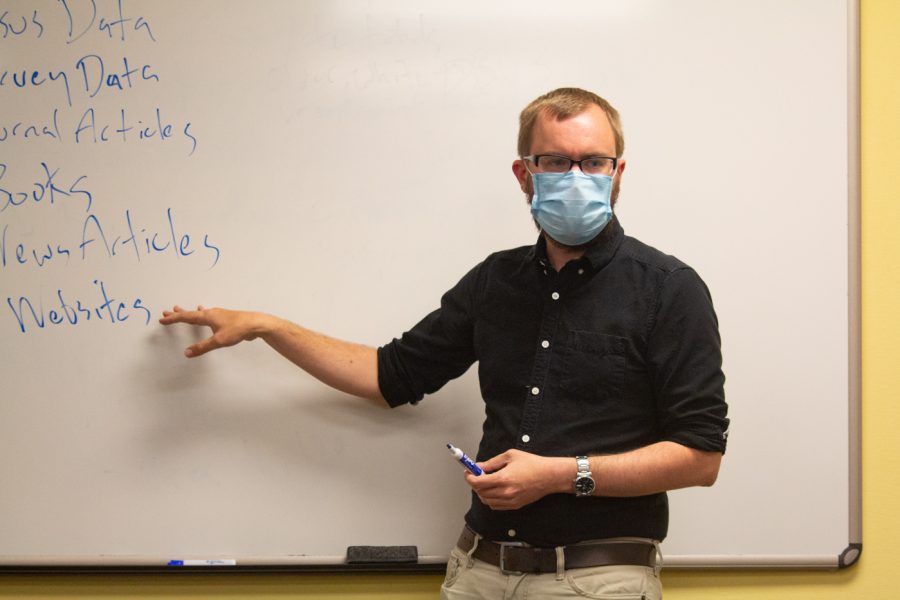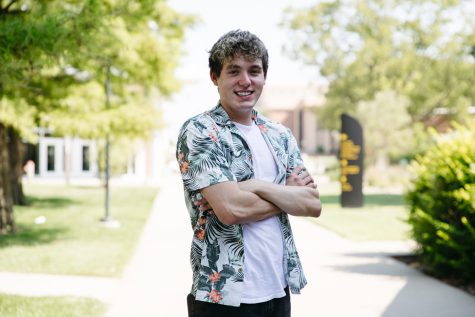Wichita State professor teaches class focused on redistricting and gerrymandering
Brian Amos teaching a class. Amos is teaching a class about redistricting and gerrymandering in the spring.
Redistricting and gerrymandering may seem like intimidating words at a glance, but Brian Amos, an assistant professor in the political science department, hopes to clear up any confusion in his upcoming political redistricting course.
Amos earned his Masters and PHD in political science from the University of Florida, specializing in legislative redistricting, election administration, and other political data analysis.
Amos is teaching political redistricting in the spring of 2022, a class that deals specifically with drawing district lines. It is open to all majors and it requires no prerequisites.
“It’s gonna be open to everybody, no prerequisites, it will be drawing districts, learning the history of it, what are the effects of it, and a big chunk of it will be trying to gerrymander or try and not gerrymander,” Amos said.
Redistricting is the process of legislative bodies drawing new boundaries in states, called districts, that are given representation largely by population size. Each district in a state has a representative that represents that district before the U.S. House.
Every ten years a census is drawn of a state’s population to configure boundaries that are appropriate for consideration. Amos said these boundaries are passed like any other bill.
“The House has to pass it, the senate has to pass it, and the governor signs or vetoes it,” Amos said.
This process happens in Topeka, the state capital, where the state legislature uses narrow criteria to judge where districts should be drawn. Special criteria, such as reallocating college students and military personnel to permanent residences, was rescinded for the 2020 consensus.
The House and Senate each have a specific committee tasked with leading the project that ultimately prepares background information that is voted on. The committees work on providing information, funneling it to the chamber floor. When on the chamber floor, it is further examined for discussion on where to draw lines.
Gerrymandering is when one party controls the state and draws these lines to help their own political party’s cause.This allows for the division of districts to advantage one political party at the expense of the other. Amos said the state of Kansas could see this in the near future.
“Ultimately the republicans are the ones that are in control of the process, where Governor Kelly could be a speed bump, but it’s largely going to be them in control of the process,” Amos said.
“What republicans could do [in the state of Kansas] is try and break up Kansas City and Johnson county, which are democratic areas of the state, connecting Kansas City to the north, and Johnson county to the South.”
Gerrymandering is also important if the incumbent draws lines along racial boundaries within the state. Considering different racial minorities may lean one way or another, grouping people into a particular district could separate them so they are a minority instead of a majority. They could also create one big district in order to not carry as much weight in a group of districts.
“In KC, African-American majority/minority districts, or like in the southwest, they might have to draw Hispanic majority/minority districts,” Amos said.
Drawing these districts takes very special attention, considering the legal interests. The Equal Protection Act in the United States Constitution allows for minorities in the state to control equal standing.
Doing this properly adjusts the imbalance and creates an equilibrium when drawing districts, allowing for groups to be correctly analyzed for representation.
Andruw Hoopes, a sophomore studying political science, said that leveling out the population is the main goal of the committees.
He said the main concern of the political districting process is trying to protect against the party differences that lead to polarization.
“There is technically no law against it … I know that there are certain requirements they have to meet based on ethnic diversity and race,” Hoopes said.
The Supreme Court ruled on the topic of gerrymandering and made it unconstitutional for those to draw districts by racial boundaries. If the boundaries are not drawn on racial boundaries purposely for the cause of hurting an opposing party, they are constitutionally upheld.
If you’d like to learn more about the process of redistricting and the dangers of gerrymandering, consider taking political redistricting in the spring. It is open to all majors across campus to help students better understand local Kansas and national politics.










Anne Lesser • Aug 30, 2021 at 1:21 pm
Will the class be open to the public? If so, cost?